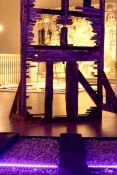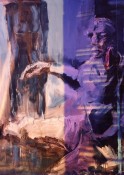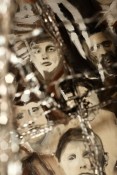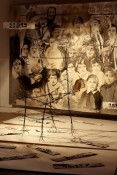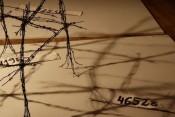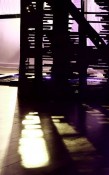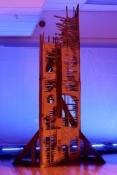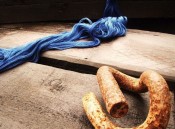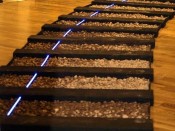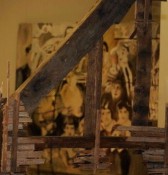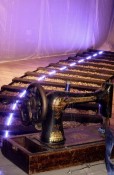8.08 – 22.08.2010 – Oxford Chabad Society Exhibition
Nicola Tucker & Maciej Hoffman
61 George Street, Oxford, OX1 2BQ, England 44-1865-200-158

Journey Line
Imagine you´re on a train. It´s overcrowded and you can´t sit down and you´re not even sure you´ll make it to your destination. Now imagine that at the end of that journey, weary, hungry and scared you have to thread a needle or a sewing machine. If you can you might live. If you can´t you might die.
Nicola Tucker unpicks the complicated tapestry of horror that was the holocaust into the individual threadlines of stories. In this exhibition she explores the stories of the tailors whose survival in the death camps hung by the threads that they could stitch into the uniforms of the camp guards. Even in such extreme circumstance those Jewish tailors subverted the threads, weaving them into the hessian torsos of the pattern uniforms to make rudimentary prayer shawls, the blue thread representing hope in the Jewish prayer robe.
At a very young age Nicola Tucker became disabled and grew up with empathy for those who suffered for their difference. By her early twenties she had been recognised for her humanitarian work in war torn Ethiopia and Eritrea. Her visit to Auschwitz, with a survivor from that concentration camp, sparked her interest in the stories of the tailors in the camps and her need to make a visual response to them. But Tucker´s work is not visual narrative – the equivalent of a fictional representation – instead it is an entry point for imagining the unimaginable and for humanizing the most inhumane of situations. Materials are carefully selected for their layers of meaning as is the imagery that Tucker presents, but the final, completing element will be the imagination of the viewer.
Maciej Hoffman´s work takes a similarly expository approach to Tucker´s, although it deals with wider themes: The discomfort felt by contemporary society when faced with the Holocaust; the erasure of individuality from those in the concentration camps. Like Tucker Hoffman uses the railway line as a metaphorical link for the journeys made by the victims of the Holocaust and plays on the spiky nature of barbed wire as it pricks the bubble of history.
The main installation is built from portraits of people. Opposite this stands the barbed wire-chair. This painting and chair are connected in a special way – it is a reverse perspective. When we look at the installation from the chair-point, the usual perspective should reduce in the direction of the image. People from the picture are looking at us and approach us bringing hidden information and their personal memories. Consider – as you sit alongside the wire chair – which is authentic from the camp and remember all these people who have become just numbers. There cannot be a comfort to conscience or calm in the face of truth and history. It is a tragedy for all humanity. Everyone must be reminded of occurrences of this magnitude.
